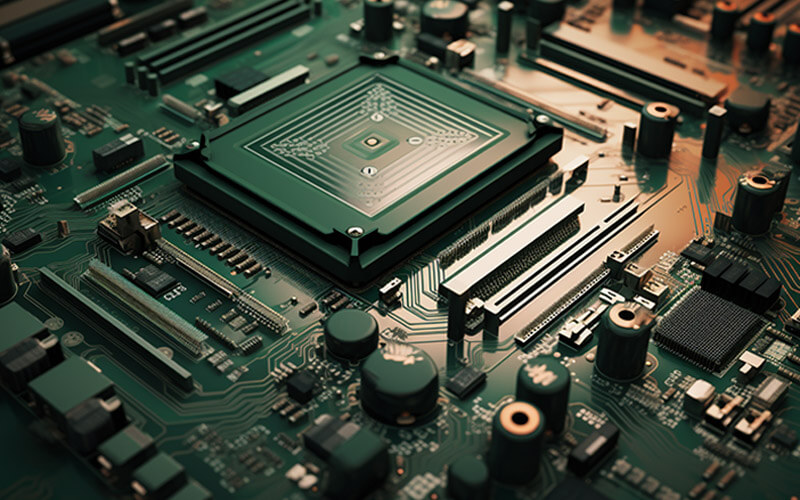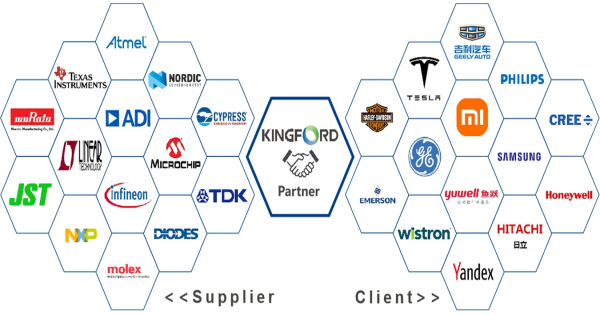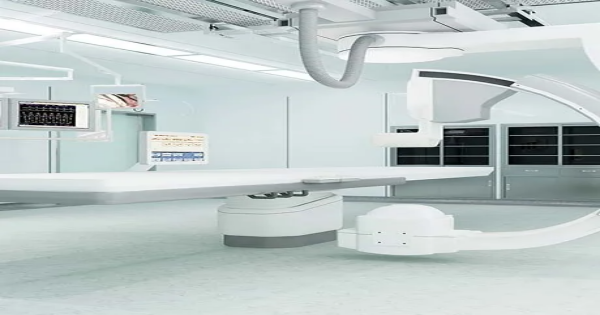Introduction–What is PCB assembly?
PCB (printed circuit board) assembly refers to the process of assembling electronic components onto a PCB to create a functional electronic circuit. This process involves placing and soldering components such as resistors, capacitors, integrated circuits, connectors, and other electronic parts onto the PCB according to a specific design and layout. PCB assembly can be done manually by skilled technicians or through automated assembly processes. Once the components are assembled, the PCB goes through testing to ensure it functions correctly before being integrated into a final product.
Certainly! There are several challenging aspects in PCB assembly:
Fine Soldering: PCB assembly requires intricate soldering, often on very small soldering points, demanding precision equipment and high-level technical skills to ensure accuracy and stability.
Complex Component Placement: Modern electronic devices commonly contain thousands of components that require intricate layout and assembly on the PCB, ensuring the correct positioning and connectivity between components is challenging.
Quality Control: High-quality PCB assembly demands strict quality control, including testing, inspection, and certification to guarantee product reliability and performance.
Handling Miniature Components: With modern electronic devices becoming increasingly smaller, the size of their components is constantly shrinking, making the correct installation and connection of these tiny components a technological challenge.
Specialized PCB Types: Certain specialized PCBs, such as flexible PCBs or high-density interconnect PCBs, require higher levels of expertise and technology for assembly and handling.
Overall, PCB assembly spans multiple technical domains, requiring advanced equipment and technology, as well as high-level technical skill and strict quality control to overcome these challenges and ensure high-quality and reliability.
Factors to Consider When Choosing PCB Assembly Solutions
Choosing the right PCB (Printed Circuit Board) assembly solutions is crucial for the success of any electronic product. Here are some key factors to consider:
Quality Assurance: Look for assembly solutions that prioritize quality assurance processes. This includes inspection techniques such as Automated Optical Inspection (AOI) and In-Circuit Testing (ICT) to ensure that each PCB assembly meets industry standards and specifications.
Experience and Expertise: Evaluate the experience and expertise of the PCB assembly service provider. Consider factors such as the number of years they have been in business, their track record with similar projects, and the qualifications of their team members.
Capabilities and Equipment: Ensure that the assembly solution provider has the necessary capabilities and equipment to handle your project requirements. This includes the ability to work with different types of PCBs (e.g., surface mount, through-hole), as well as specialized processes like ball grid array (BGA) soldering.
Prototyping and Testing Services: Look for assembly solutions that offer prototyping services, allowing you to test and iterate on your designs before full-scale production. Additionally, consider whether the provider offers comprehensive testing services to identify and address any issues early in the process.
Flexibility and Scalability: Choose a PCB assembly solution that can accommodate changes in your project requirements and scale production as needed. This includes flexibility in manufacturing volumes, lead times, and the ability to adapt to design revisions.
Cost and Pricing Structure: While cost is an important consideration, it should not be the sole determining factor. Evaluate the overall value proposition offered by the assembly solution provider, considering factors such as quality, reliability, and customer support in addition to price.
Location and Logistics: Consider the geographical location of the assembly solution provider and its impact on logistics, shipping times, and communication. Depending on your preferences and requirements, you may opt for local or offshore assembly services.
Compliance and Certifications: Ensure that the assembly solution provider adheres to relevant industry standards and certifications, such as ISO 9001 for quality management systems and RoHS compliance for environmental regulations.
Customer Support and Communication: Assess the level of customer support and communication offered by the assembly solution provider. Look for a responsive and transparent partner who will keep you informed throughout the manufacturing process and address any concerns promptly.
References and Reviews: Seek out references and reviews from other clients who have worked with the assembly solution provider. This can provide valuable insights into their reputation, reliability, and overall performance.
By carefully considering these factors, you can choose a PCB assembly solution that meets your project requirements and helps ensure the success of your electronic product.
Evaluating Potential PCB Assembly Partners
Based on the information gathered from various sources, the major regions that offer PCB assembly services globally include:
| Advantages | Disadvantages | |
| United States |
|
|
| Europe |
|
|
| Japan and South Korea |
|
|
| China |
|
|
United States:
Advantages: The US PCB assembly industry prioritizes high-quality, technological innovation, and reliability, making it suitable for high-end markets and demanding products. US manufacturing has a competitive edge in quality control, technological innovation, and intellectual property protection.
Disadvantages: The manufacturing costs are relatively high, which may limit competitiveness in mass production and pricing compared to other regions.
Europe:
Advantages: Europe excels in high-quality, environmental consciousness, and reliability within the PCB industry. The region implements strict quality standards and innovative manufacturing processes, catering to high-end markets and specific industries.
Disadvantages: Similar to the US, higher manufacturing costs may limit competitiveness in mass production.
Japan and South Korea:
Advantages: Both countries lead in PCB manufacturing technology, having world-class production capabilities, strict quality control, and a focus on small batch, high-quality production.
Disadvantages: Higher labor costs and production expenses may pose challenges.
China’s Advantages in PCB Assembly:
Scale and Capacity: China offers vast manufacturing scale and capacity for PCB assembly, catering to high-volume production needs.
Cost Efficiency: The competitive cost structure in China makes it an attractive destination for cost-effective PCB assembly services.
Technological Advancements: Continuous investments in technology and automation enhance the efficiency and quality of PCB assembly processes in China.
In summary, China’s advantage in PCB assembly lies in its economies of scale, cost-effectiveness, high-volume production capabilities, and continuously improving manufacturing technology. This makes China one of the main global providers of PCB assembly services.
Main regions of PCB Assembly in China
Are you searching for top-notch PCB assembly services in China? Look no further! China boasts several key regions renowned for their expertise and capabilities in PCB assembly. Let’s delve into these prominent areas and discover the advantages they offer.
Overview of Key Manufacturing and Assembly Bases in China
| Advantages | Disadvantages | |
| Shenzhen |
|
|
| Guangzhou |
|
|
| Dongguan |
|
|
| Shanghai |
|
|
In-Depth Analysis of Pros and Cons
Shenzhen:
Advantages:
Industry Hub: Shenzhen is a major electronics manufacturing hub in China, with a dense network of PCB manufacturers and assembly service providers. This clustering effect provides a wide range of options and fosters innovation.
Technological Expertise: PCB assembly factories in Shenzhen typically have access to advanced equipment and technologies, enabling high-quality assembly services.
Supply Chain Advantage: Situated in the Pearl River Delta Economic Zone, Shenzhen benefits from well-developed logistics and supply chain networks, facilitating quick access to raw materials and components.
Flexibility and Responsiveness: PCB assembly factories in Shenzhen are known for their flexibility and quick response times, accommodating customized requirements and urgent orders efficiently.
Disadvantages:
Price Competition: Due to intense market competition, there is significant price pressure in Shenzhen’s PCB assembly market.
Intellectual Property Risks: There may be risks associated with intellectual property protection, particularly with smaller-scale assembly factories.
Shanghai:
Advantages:
Economic Development: Shanghai, as one of China’s economic centers, offers well-developed infrastructure and logistics networks, ensuring quality services and convenient transportation.
Technological Expertise: PCB assembly factories in Shanghai emphasize technology and quality, catering to high-end customer demands.
Disadvantages:
Higher Costs: Compared to other regions, the cost of production in Shanghai may be higher, resulting in increased prices for PCB assembly services.
Guangzhou:
Advantages:
Geographical Advantage: Located in southern China, Guangzhou’s proximity to Hong Kong and Macau facilitates international trade and logistics.
Competitive Pricing: PCB assembly services in Guangzhou may be more competitively priced compared to Shenzhen and Shanghai.
Disadvantages:
Limited Technological Expertise: PCB assembly factories in Guangzhou, typically smaller in scale, may lack advanced technology and service quality compared to other regions.
Dongguan:
Advantages:
Manufacturing Center: Dongguan serves as a significant manufacturing center in southern China, with abundant resources and experience in manufacturing.
Lower Costs: Due to its inland location, Dongguan’s production costs are relatively lower, offering cost-effective PCB assembly services.
Disadvantages:
Limited Technological Expertise: Similar to Guangzhou, PCB assembly factories in Dongguan may have limited technological expertise compared to Shenzhen or Shanghai.
Identifying the Optimal Base for Your PCB Needs
Overall, China’s primary manufacturing and assembly base for electronics is highlighted by the significant advantage of Shenzhen. Shenzhen stands out as a global electronics manufacturing hub with a well-established supply chain and mature manufacturing infrastructure, providing high-tech equipment and abundant talent resources.
As a leading PCB manufacturer and assembler, Kingda leverages the advantages of Shenzhen’s electronic manufacturing ecosystem. Our company possesses state-of-the-art production facilities and a skilled technical team, enabling us to deliver cost-effective, high-quality PCB assembly services. We prioritize stringent product quality management, adhering to international standards, and offering tailored production solutions to meet diverse customer needs.
If you are seeking high-quality PCB assembly services and are in need of a reliable partner, we encourage you to get in touch with us immediately. Our team is committed to providing customized solutions and exceptional service.

A Comprehensive Guide to Checking PCB Assembly Quality
When it comes to ensuring the quality of PCB assembly, there are several important factors to consider. Here are some key aspects to check for assessing the quality of PCB assembly:
Visual Inspection:
Check the surface of the PCB for flatness and uniformity. An uneven surface may indicate defects in the manufacturing process.
Inspect for any visible faults or discrepancies in color and brightness of the PCB and components.
X-Ray Inspection:
X-ray testing can identify hidden defects within the PCB, such as internal layer mismatches, opens, or shorts. This non-destructive method provides accurate defect detection without disassembling the board.
Functional Testing:
Conduct functional circuit testing (FCT) to ensure the integrity and reliability of the circuitry. Verify that components are correctly installed and meet electrical connection requirements.
Quality Control Processes:
Implement rigorous quality control measures throughout the PCB assembly process. This includes visual inspections at various stages like solder paste printing, component placement, reflow soldering, and post-assembly checks.
Comprehensive Acceptance Criteria:
Establish comprehensive acceptance criteria encompassing design, process, and overall approval. Prototype testing, sample evaluation, and batch production assessments are crucial for verifying PCB assembly quality.
Conclusion
In conclusion, navigating the world of PCB assembly solutions can be complex, but with the ultimate B2B guide to PCB assembly solutions, you’re equipped with the knowledge and tools to make informed decisions for your business. From understanding the PCB assembly process to evaluating quality standards and choosing the right supplier, this guide has covered all the essential aspects to consider.
Now, it’s time to take action and elevate your PCB assembly processes to new heights. Whether you’re looking to streamline production, enhance product quality, or reduce costs, partnering with a trusted PCB assembly provider is key. At Kingda, we’re committed to delivering top-notch PCB assembly solutions tailored to your unique needs.
Take the next step towards excellence in PCB assembly. Contact us today to discuss your requirements, explore our capabilities, and start a partnership that drives success for your business. Let’s bring your PCB assembly projects to life and unlock endless possibilities together!



